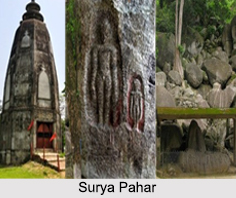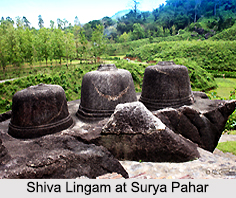 Located at the banks of the Brahmaputra River in the state of Assam, Surya Pahar is a historically significant but relatively unknown archaeological site in the state. Also known as Sri Surya Pahar, this ancient heritage site is situated about 12 km south east of Goalpara town and 132 km northwest of the city of Guwahati.
Located at the banks of the Brahmaputra River in the state of Assam, Surya Pahar is a historically significant but relatively unknown archaeological site in the state. Also known as Sri Surya Pahar, this ancient heritage site is situated about 12 km south east of Goalpara town and 132 km northwest of the city of Guwahati.
History of Surya Pahar
As evident from the numerous sculptures and other relics belonging to Hinduism, Jainism and Buddhism, the significance of Sri Surya Pahar is that it was once a confluence of all the three religions. In an area of about a kilometre on a hilly terrain, the site of Surya Pahar is known to have several rock- cut Shiva Lingams, and votive stupas along with the deities of Hindu, Buddhist and Jain pantheon. It is believed that the Indian sage, Ved Vyasa engraved 99, 999 Shiva Lingams in order to build the second Kashi, where there were about 1 lakh Shiva Lingams.
According to historians, it is believed that the place was once a culturally advanced capital of an ancient kingdom, which was later destroyed by the political turmoil and the invasion of enemy kings. Due to its close proximity to the Brahmaputra River, Sri Surya Pahar might have been an important trade centre or seat of administration in the past.
Hinduism in Surya Pahar
As per Hindu traditions, it is said that Lord Surya occupied a prominent place in Assam"s cultural history. The name Surya Pahar implies that the site was perhaps associated with the worship of Lord Surya. In the sacred Hindu text of Kalika Purana, there are also mentions of two seats of Sun worship in Assam.
 In Hinduism, it is also believed that Surya Pahar is a slab of carved stone that is correlated to Lord Surya. Circular carving had been done on the slab and the inner circle of the slab has been identified as Prajapati, while the outer circle is in the form of 12 lotus petals. Each of these petals has the seated figure of Aditya, who are described as the 12 solar divinities namely Dhatri, Mitra, Aryaman, Rudra, Varuna, Surya, Bhaga, Vivasvan, Pushan, Savitri, Tvastri and Vishnu.
In Hinduism, it is also believed that Surya Pahar is a slab of carved stone that is correlated to Lord Surya. Circular carving had been done on the slab and the inner circle of the slab has been identified as Prajapati, while the outer circle is in the form of 12 lotus petals. Each of these petals has the seated figure of Aditya, who are described as the 12 solar divinities namely Dhatri, Mitra, Aryaman, Rudra, Varuna, Surya, Bhaga, Vivasvan, Pushan, Savitri, Tvastri and Vishnu.
Apart from these, several relics of Hindu deities have also been found here among which the notable ones include sculptural panels of Shiva and Vishnu. Other carved figures include Hari Hara, Ganesha and Vishnupadas. Similar to `Surya Chakra`, a `Chandra Chakra` has also been excavated but in a severely eroded condition.
Jainism in Surya Pahar
The natural caves of Surya Pahar are the only existing place in the north east India, where Jain remains were found. Foot prints of the followers of the first Tirthankara, Lord Rishabhanatha can be found in this historical site. Traditional iconography of Jains has been found at the hill. Jain carvings on rocks and other inscriptions in the site belonging to 9th century AD have been found. On a big granite boulder, two figures are carved in standing position. At the top of the hill another figure is carved out which is identified as Adinath, the traditional founder of Jainism.
Buddhism in Surya Pahar
The presence of 25 votive stupas varying from sizes and shapes are carved out from granite boulders have been found in north western slopes of Surya Pahar. These stupas have established the fact that Buddhist influence in Kamarupa, an ancient kingdom of Assam, arrived much earlier than other parts of the country which is contradictory to the previously held beliefs.
The stupas found at this site have three distinct structural features: Harmika, Medhi Anda and Vedi. There are three monolithic stupas that stand at Sri Surya Pahar, also known as Uddeshika Stupa, which were carved in the memory of Lord Buddha. In the 9th to 10th century, the site was pre occupied by the Hindu devotees who had carved out Shiva Lingams along with Younipith on the boulders which still can be witnessed in the stupa complex. Terracotta plaques in the stupas having carved figures of Buddha have been frequently found. The reign of Pala dynasty in this region, during 9th century, has contributed a lot in the spread of Buddhism.
Excavations in Surya Pahar
In 1993, the Archaeological Survey of India started excavation works in Surya Pahar and that was carried out till 1996 and 1997. It was during this time, when the archaeologists discovered a Buddhist stupa along with monastery or vihara, which were estimated to belong to the 8th or 9th century AD. Earlier excavations had exposed startling relics including heads of deities with Karanda Mukuta, Kirtimukha, vestiges of stupa, terracotta mortar- pestle and vessels used in rites, designed tiles, Apsaras, Purnaghat, etc.
In the later years, further excavations revealed two temple complexes along with the sculptures of Lord Ganesha and the Mahishasuramardini. Other than these, ancient stone paved water kund was also discovered. Most of the antiquities found in this site have been displayed at a nearby museum set up by the Archaeological Survey of India.
Visiting Information on Surya Pahar
The nearest railway station is at Goalpara, which is located at a distance of about 16 km from the archaeological site of Surya Pahar. And the Lokpriya Gopinath Bordoloi International Airport in Borjhar is the closest airport at almost 109 km from the site.



















